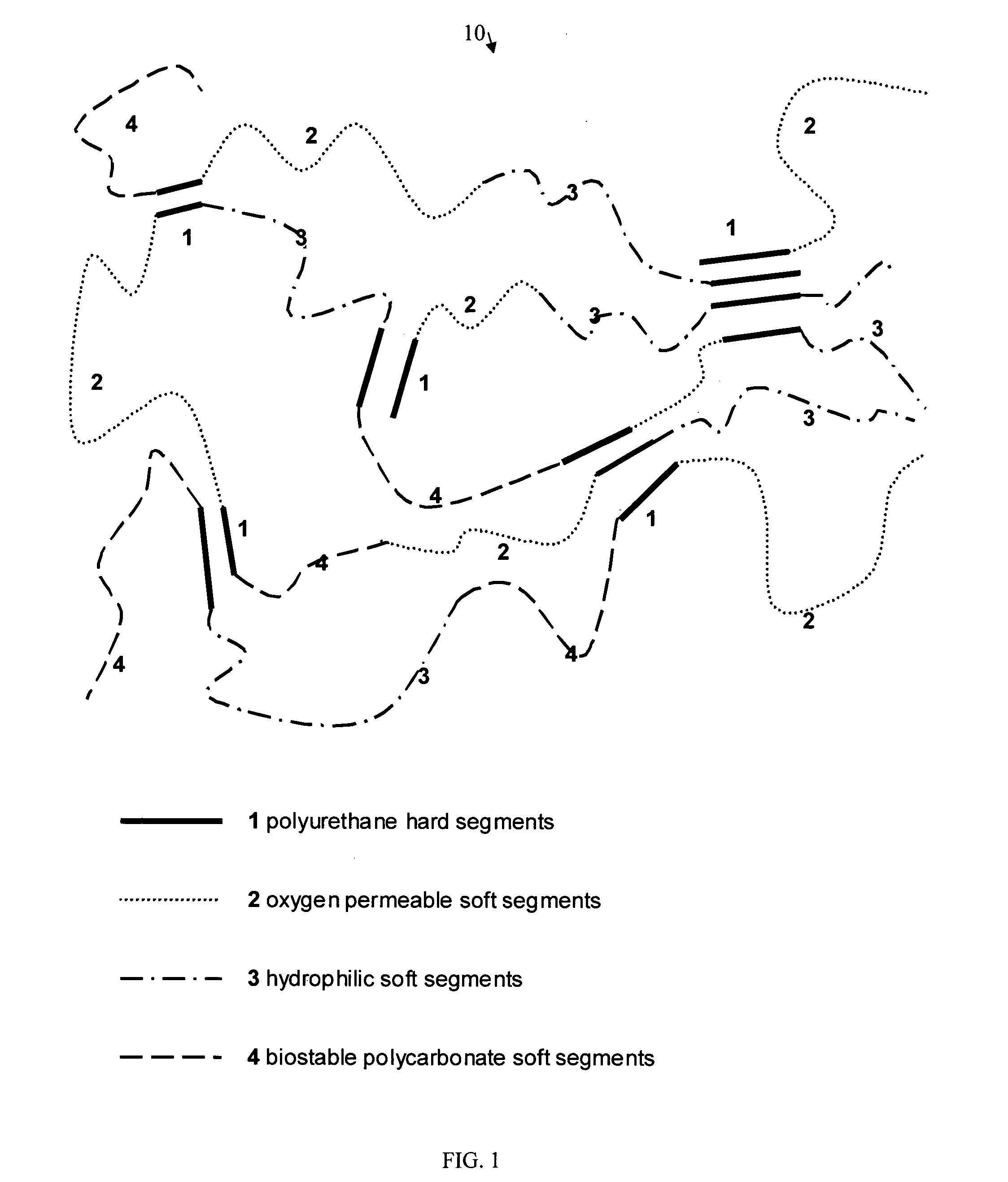[0006] The foregoing and other objectives, features and advantages of the invention will be more readily understood upon consideration of the following detailed description of the invention, taken in conjunction with the accompanying drawings.
[0007] Drawing 1 is an illustration of a possible arrangement of the hard segments and soft segments of several
polymer chains in a biocompatible multipolymer according to the present invention.
[0008] In its preferred embodiments, the present invention is a multipolymer 10, a high molecular weight polymeric organic material consisting of different types of monomeric units, suitable for use in a glucose sensor or in an
oxygen sensor which is immersed for substantial periods of time in blood or interstitial fluids of the
human body. Referring to FIG. 1 multipolymer 10 includes hard segments 1,
polyurethane domains with highly crystalline or glassy nature that associate with each other either interchain to provide the physical tensile strength of membranes made from the
polymer. The energetically favorable associations between the individual molecular backbones provide regions that hold the chains together and require a substantial energy input to disrupt. Soft segments of the three different types, oxygen-permeable soft segments 2, hydrophilic soft segments 3, and biostable
polycarbonate soft segments 4, are randomly situated in the individual molecular chains. Any type of soft segment may be directly attached to a hard segment, or to another type of soft segment. There may be multiple domains of each kind of segment, hard or soft, in the polymer material. The soft segments have a low associative energy with other soft segments or with hard segments, so a lesser degree of force would be required to dissociate the soft segments, giving membranes prepared from the polymer a rubbery or flexible character. The less crystalline or glassy nature of regions containing soft segments are the regions where oxygen and aqueous solutions may freely permeate the membrane. The
polycarbonate soft segments 4 likewise are less crystalline or glassy than the hard segments 1, but their resistance to degradation by the reactive chemicals and enzymes found in the tissue fluids of living human beings gives a greater degree of biostability to membranes prepared from the polymer of the present invention containing such
polycarbonate domains.
[0009] Again referring to FIG. 1, more specifically, in one preferred embodiment the multipolymer consists of (1) hard segments or domains of substantially crystalline or glassy structure 1, that would have a high melting points or
glass transition temperatures if prepared as homopolymers, and (2) soft segments, of substantially amorphous structure 2, 3, and 4, that would have low melting or
glass transition temperatures if prepared as homopolymers, that are permeable to aqueous solutions containing organic solutes such as glucose, and to dissolved oxygen, and are substantially stable to degradation in a biological environment. These soft domains (2, 3, 4) are oligomeric or polymeric segments of materials which intersperse and separate the hard domains 1 of the multipolymer, which further comprise three distinct types or classes of polymeric materials: (i) polymer domains 2 that confer
oxygen permeability to the material, (ii) polymer domains 3 that confer hydrophilicity to the material, and (iii) polymer domains 4 that confer biostability to the material, specifically domains comprising polycarbonate-type structures.
[0010] The hard domains 1 of the multipolymer confer
physical strength and durability allowing the
casting of dense, non-porous semi-permeable membranes or hollow fibers with sufficient tensile strength and elasticity for use over relatively long periods of times immersed in fluids of the
human body. The hard domains of the multipolymer comprise
polyurethane structures that may also contain some
urea-type linkages (N—(CO)—N) as well as urethane-type linkages (N—(CO)—O). These
polyurethane-type polymers result from the reaction of various types of difunctional isocyanates (
isocyanate group: R—N═C═O) with difunctional amines (R—NH2) or alcohols (ROH), where R may be aliphatic, cycloaliphatic,
aryl, hetero-
aryl, or alkylaryl in nature. Such polyurethane structures are known to be strong, durable materials suitable for uses where they are in contact with biological solutions in living organisms, as described in U.S. Pat. No. 5,428,123.
[0011] The soft domains 2, 3, and 4 of the block
copolymer confer permeability for both water solutions of compounds and for oxygen, but the dense non-porous nature of membranes cast from these polymers are adequate to exclude insoluble materials such as cells and suspensions of
solid materials. Thus the membranes or fibers made from the multipolymers of the present invention allow aqueous solutes and oxygen to permeate the membranes while disallowing
solid materials to pass through, as disclosed in U.S. Pat. No. 5,428,123.
 Login to View More
Login to View More 
